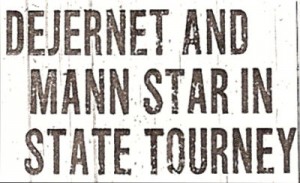A Basketball Classic for Black History Month
February 11, 2013In 1930 the Indiana State Title game in boys basketball came down to a thrilling finale, as it often does. The rival stars of this clash were featured in the…
 In 1930 the Indiana State Title game in boys basketball came down to a thrilling finale, as it often does. The rival stars of this clash were featured in the following story on the front page of the Indianapolis Recorder:
In 1930 the Indiana State Title game in boys basketball came down to a thrilling finale, as it often does. The rival stars of this clash were featured in the following story on the front page of the Indianapolis Recorder:
“The hero of all Washington [Indiana] is a rangy black boy by the name of Dave DeJernet, who, on Saturday past, led his team mates of the Washington High school through three gruelling basketball contests to capture the state title.
“DeJernet plays the center position.
“In the first game of the day, DeJernet and his team mates vanquished Franklin, Ind., by a 13-to-11 score. They followed this hope in the semi-finals by whipping Connersville, 35 to 24, and then fought it out with Muncie, the 1928 champions, for the highest honors in the state.
“The final game resulted in a spectacular battle between DeJernet, the Washington high center, and [Jack] Mann, bigger and taller, also colored [sic]. Each of these players contributed the high share of his team’s points. Dejernet made five baskets and one free throw for a total of eleven. Mann made three baskets for a total of six points. Not a single foul was called on DeJernet and only one on Mann. The final score was Washington 32, Muncie 21.” (Indianapolis Recorder, March 22, 1930)
Just three years before this game, pressure to segregate Indiana high schools led to the opening of all-black high schools in Indianapolis, Gary and Evansville. Not until 1941 would Crispus Attucks High School be accepted into the IHSAA, eventually winning the boys’ state basketball championship in 1955.
So it may be surprising that in 1930, following close on a period of Klan domination, African Americans played in such a high profile game and to such widespread acceptance and acclaim.
Muncie led 14-12 after the first half. The Washington newspaper picks up the tale at that point:
“Mann had out-tipped Davey in the first half and [Coach] Burl [Friddle] said “Dave if we’re going to win this ball game, we’re going to have to have that tip at center.” The big boy tickled everybody in the room when he assured Burl with “that’s alright boys, I’m going in there for you; I’ll get that tip this half. I was just beginning to ‘feel it’ in the last few minutes of the first half. Don’t worry, I’ll be IN there.”
“And was he ‘in there’?” The headlines of any paper printed since that final game, will tell the story. On the very first play, Davey tipped to Gilmore and the inspired forward passed to Jingles, Davison fouling him. . . . Then, in a scrimmage under the Washington basket, Big Davey came up with the ball, dropped it through and the Hatchets were leading, 16 to 14.” (Washington Democrat, March 17, 1930)
Hundreds of fans escorted the triumphant Hatchets back to Washington along State Road 57:
“At this point ‘Big Dave” DeJernett, our big colored [sic] pivot man, got the thrill of his life when he was permitted to turn in a false fire alarm from Box 13. Fire Chief Roy Yeager had promised Dave a free ride on the truck and the privilege of turning in the alarm – providing the Hatchets won the state championship.
“The Central fire truck responded to the alarm, and the ten members of the Hatchet team piled on the truck, Big Dave seated in a gayly decorated chair on the very top.” (Washington Democrat, March 17, 1930)
Bob Barnet wrote in the Muncie newspaper:
“The game was featured by a thrilling duel between the two great Negro [sic] centers, Mann and DeJernet. Both of them easily the class of the state, the two great giant pivot men fought a battle that will long be remembered.” (Muncie Sunday Star, March 16, 1930)
Barnet went on to note sympathetically that Muncie had had to play a much tougher game in the semi-finals and that Mann had twisted his ankle toward the end of the title game.
The 1930 championship game is fascinating because in the midst of what was still a very difficult environment for African Americans in Indiana – DeJernet later received death threats from the Klan – both black and white Hoosiers took pride in their hometown heroes. Dave (Robert) DeJernet and Jack Mann are in the Indiana Basketball Hall of Fame, and there is a campaign to place a historical marker by DeJernet’s home in Washington.
In February and March, Indiana Humanities is exploring the topic of “rivalry,” as part of its Spirit of Competition theme. This post was written by Nancy Conner, director of grants and coordinator of Novel Conversations.


